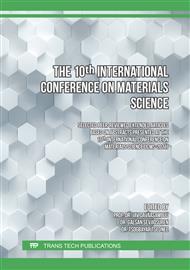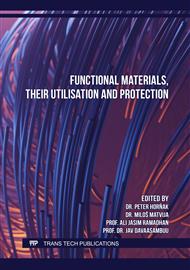[1]
F. Risplendi, A. Ricci, G. Cicero,Functionalization layer effect on the mechanical properties of silicon based micro-cantilever mass sensor: A theoretical study , Sens. Actuators B, 195 (2014) 177-180.
DOI: 10.1016/j.snb.2013.12.116
Google Scholar
[2]
X. Liang, S.L. Hu, S.P. Shen, Effects of surface and flexoelectricity on a piezoelectric nanobeam, Smart Mater. Struct, 23 (2014) 035020-1-8.
DOI: 10.1088/0964-1726/23/3/035020
Google Scholar
[3]
Y.G. Sun, V. Kumar, I. Adesida, Buckled and wavy ribbons of GaAs for high-performance electronics on elastomeric substrates, Adv. Mater., 18 (2006) 2857.
DOI: 10.1002/adma.200600646
Google Scholar
[4]
K. Gansel Justyna, Thiel Michael, S. Rill Michael, Gold helix photonic metamaterial as broadband circular polarizer, Science, 325 (2009) 1513.
DOI: 10.1126/science.1177031
Google Scholar
[5]
Y. Zheng, W. Smith, J. Jackson, Multiscale metallic metamaterials, Nat. Mater., 15(2016) 1100.
Google Scholar
[6]
X.H. Liu, T.T. Ma, Y.S. Xu, Rolled-up SnO2 nanomembranes: A new platform for effificient gas sensors, Sens. Actuator. B, 264 (2018) 92.
DOI: 10.1016/j.snb.2018.02.187
Google Scholar
[7]
R. Sharma, C.C. BofBufon, D. Grimm, R. Sommer, A. Wollatz, J. Schadewald, D.J. Thurmer, P.F. Siles, M. Bauer, and O.G. Schmidt, Large-area rolled-up nanomembrane capacitor arrays for electrostatic energy storage, Adv. Energy Mater., 4 (2014) 1301631.
DOI: 10.1002/aenm.201301631
Google Scholar
[8]
G. Li, M. Yarali, A. Cocemasov, In-plane thermal conductivity of radial and planar Si/SiOx hybrid nanomembrane superlattices, ACS Nano, 11 (2017) 8215.
DOI: 10.1021/acsnano.7b03219.s001
Google Scholar
[9]
Z. Chen, G. Huang, I. Trase, X. Han, and Y. Mei, Ian Trase etc.Mechanical self-assembly of a strain-engineered flexible layer: Wrinkling, Rolling, and Twisting,Phys. Rev. Appl., 5 (2016) 017001.
DOI: 10.1103/physrevapplied.5.017001
Google Scholar
[10]
Y. Saqier, G.H. Yun, B. Narisu, Effect of size dependent surface stress on bending of ultrathin nanofilms, Applied Physics Express, 13 (2020) 115004.
DOI: 10.35848/1882-0786/abc1f7
Google Scholar
[11]
James Bowen, David Cheneler, On the origin and magnitude of surface stresses due to metal nanofifilms, [J]. Nanoscale, 8 (2016) 4245.
DOI: 10.1039/c5nr08789a
Google Scholar
[12]
B. Narsu and G.H. Yun, Modelling of the magnetostrictive trilayer cantilever for actuators, J. Phys. D: Appl. Phys. 41 (2008) 095307.
DOI: 10.1088/0022-3727/41/9/095309
Google Scholar



